HRM Practices in Foreign MNCs in China
VerifiedAdded on 2020/06/04
|12
|3247
|82
AI Summary
This assignment examines Human Resource Management (HRM) practices implemented by foreign multinational corporations (MNCs) operating within the People's Republic of China (PRC). Students are required to analyze data collected through various means, applying thematic analysis techniques to identify key patterns and trends in these HRM practices. The analysis should consider the institutional context of China and draw upon relevant academic literature, including specific sources provided in the assignment document.
Contribute Materials
Your contribution can guide someone’s learning journey. Share your
documents today.
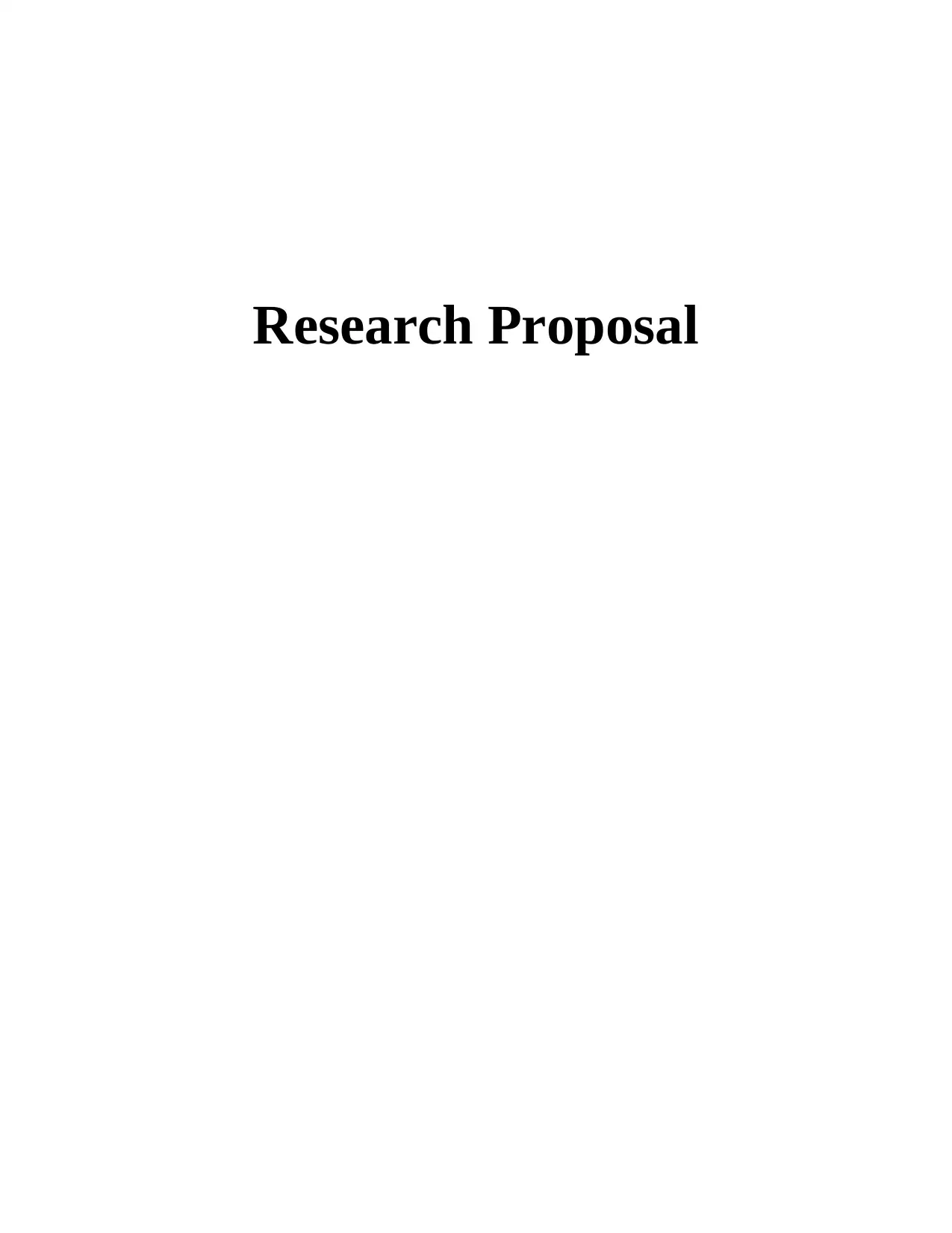
Research Proposal
Secure Best Marks with AI Grader
Need help grading? Try our AI Grader for instant feedback on your assignments.
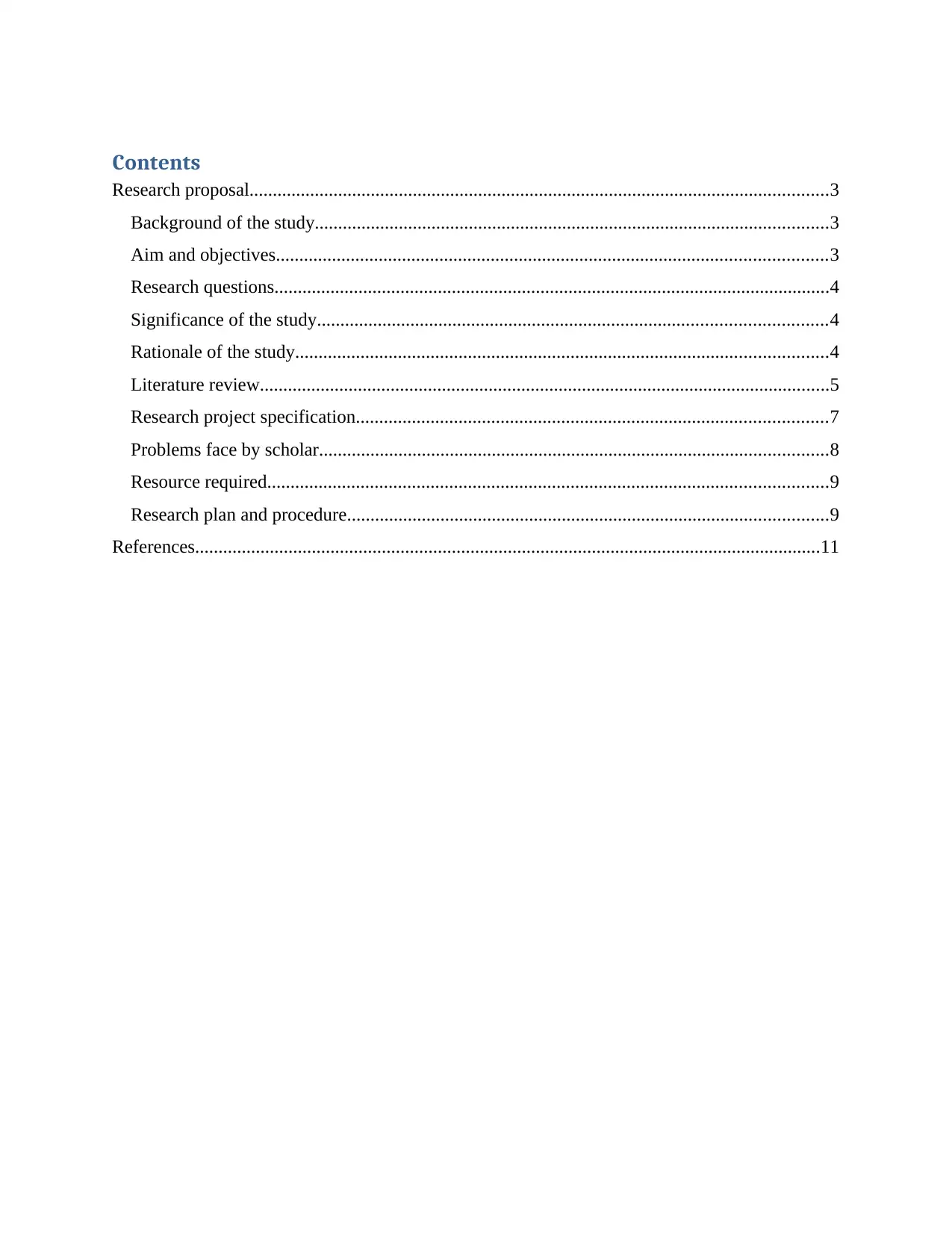
Contents
Research proposal............................................................................................................................3
Background of the study..............................................................................................................3
Aim and objectives......................................................................................................................3
Research questions.......................................................................................................................4
Significance of the study.............................................................................................................4
Rationale of the study..................................................................................................................4
Literature review..........................................................................................................................5
Research project specification.....................................................................................................7
Problems face by scholar.............................................................................................................8
Resource required........................................................................................................................9
Research plan and procedure.......................................................................................................9
References......................................................................................................................................11
Research proposal............................................................................................................................3
Background of the study..............................................................................................................3
Aim and objectives......................................................................................................................3
Research questions.......................................................................................................................4
Significance of the study.............................................................................................................4
Rationale of the study..................................................................................................................4
Literature review..........................................................................................................................5
Research project specification.....................................................................................................7
Problems face by scholar.............................................................................................................8
Resource required........................................................................................................................9
Research plan and procedure.......................................................................................................9
References......................................................................................................................................11
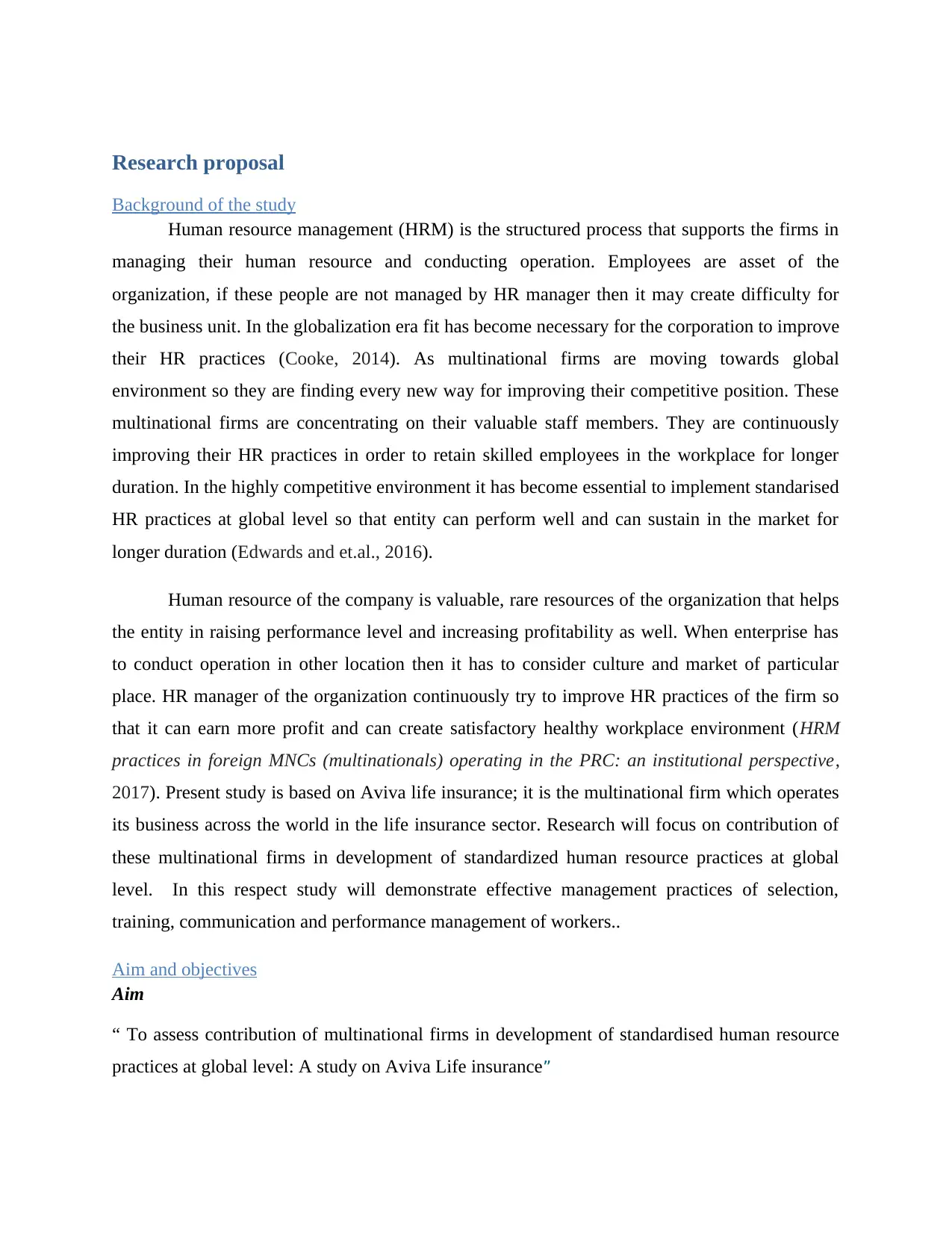
Research proposal
Background of the study
Human resource management (HRM) is the structured process that supports the firms in
managing their human resource and conducting operation. Employees are asset of the
organization, if these people are not managed by HR manager then it may create difficulty for
the business unit. In the globalization era fit has become necessary for the corporation to improve
their HR practices (Cooke, 2014). As multinational firms are moving towards global
environment so they are finding every new way for improving their competitive position. These
multinational firms are concentrating on their valuable staff members. They are continuously
improving their HR practices in order to retain skilled employees in the workplace for longer
duration. In the highly competitive environment it has become essential to implement standarised
HR practices at global level so that entity can perform well and can sustain in the market for
longer duration (Edwards and et.al., 2016).
Human resource of the company is valuable, rare resources of the organization that helps
the entity in raising performance level and increasing profitability as well. When enterprise has
to conduct operation in other location then it has to consider culture and market of particular
place. HR manager of the organization continuously try to improve HR practices of the firm so
that it can earn more profit and can create satisfactory healthy workplace environment (HRM
practices in foreign MNCs (multinationals) operating in the PRC: an institutional perspective,
2017). Present study is based on Aviva life insurance; it is the multinational firm which operates
its business across the world in the life insurance sector. Research will focus on contribution of
these multinational firms in development of standardized human resource practices at global
level. In this respect study will demonstrate effective management practices of selection,
training, communication and performance management of workers..
Aim and objectives
Aim
“ To assess contribution of multinational firms in development of standardised human resource
practices at global level: A study on Aviva Life insurance”
Background of the study
Human resource management (HRM) is the structured process that supports the firms in
managing their human resource and conducting operation. Employees are asset of the
organization, if these people are not managed by HR manager then it may create difficulty for
the business unit. In the globalization era fit has become necessary for the corporation to improve
their HR practices (Cooke, 2014). As multinational firms are moving towards global
environment so they are finding every new way for improving their competitive position. These
multinational firms are concentrating on their valuable staff members. They are continuously
improving their HR practices in order to retain skilled employees in the workplace for longer
duration. In the highly competitive environment it has become essential to implement standarised
HR practices at global level so that entity can perform well and can sustain in the market for
longer duration (Edwards and et.al., 2016).
Human resource of the company is valuable, rare resources of the organization that helps
the entity in raising performance level and increasing profitability as well. When enterprise has
to conduct operation in other location then it has to consider culture and market of particular
place. HR manager of the organization continuously try to improve HR practices of the firm so
that it can earn more profit and can create satisfactory healthy workplace environment (HRM
practices in foreign MNCs (multinationals) operating in the PRC: an institutional perspective,
2017). Present study is based on Aviva life insurance; it is the multinational firm which operates
its business across the world in the life insurance sector. Research will focus on contribution of
these multinational firms in development of standardized human resource practices at global
level. In this respect study will demonstrate effective management practices of selection,
training, communication and performance management of workers..
Aim and objectives
Aim
“ To assess contribution of multinational firms in development of standardised human resource
practices at global level: A study on Aviva Life insurance”
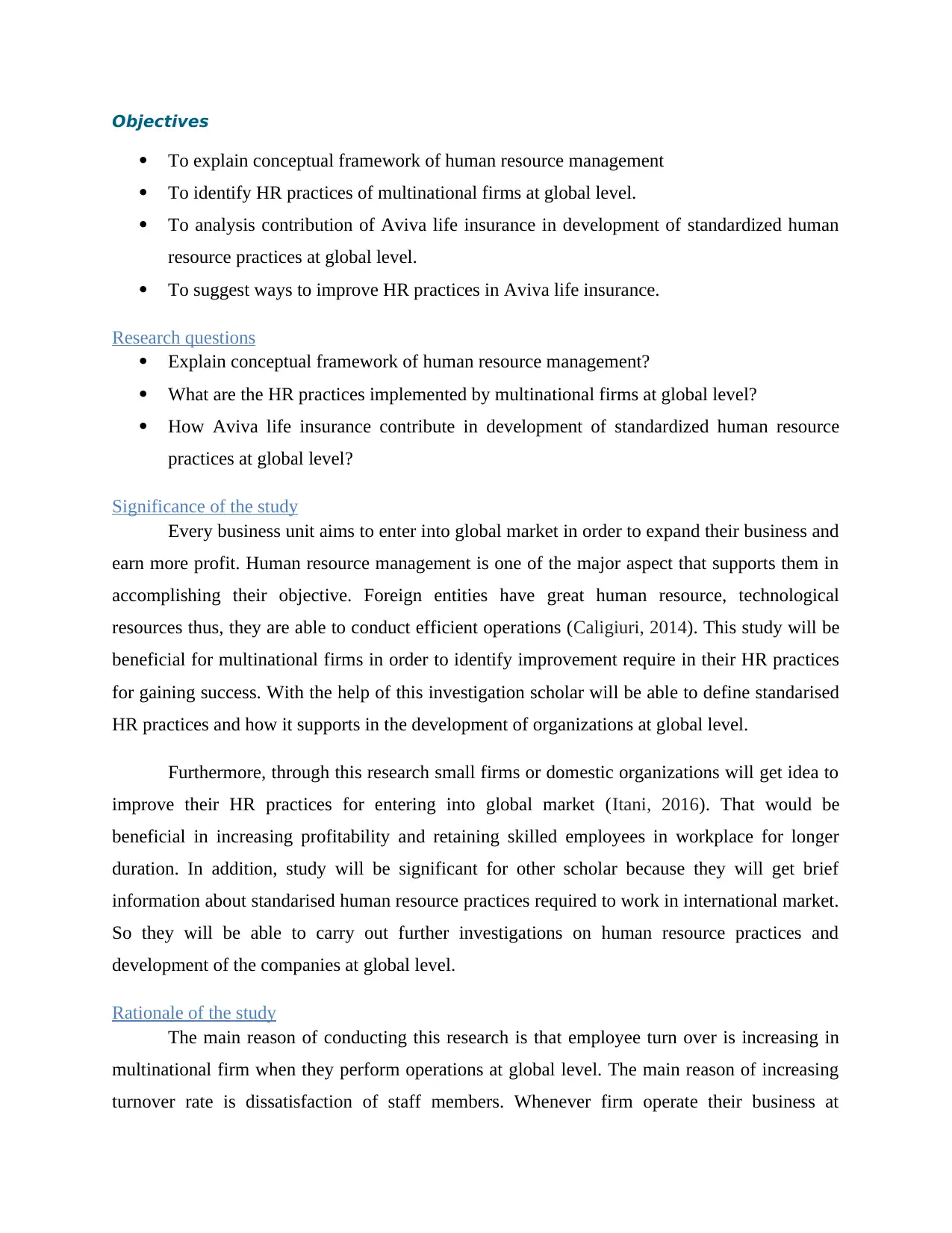
Objectives
To explain conceptual framework of human resource management
To identify HR practices of multinational firms at global level.
To analysis contribution of Aviva life insurance in development of standardized human
resource practices at global level.
To suggest ways to improve HR practices in Aviva life insurance.
Research questions
Explain conceptual framework of human resource management?
What are the HR practices implemented by multinational firms at global level?
How Aviva life insurance contribute in development of standardized human resource
practices at global level?
Significance of the study
Every business unit aims to enter into global market in order to expand their business and
earn more profit. Human resource management is one of the major aspect that supports them in
accomplishing their objective. Foreign entities have great human resource, technological
resources thus, they are able to conduct efficient operations (Caligiuri, 2014). This study will be
beneficial for multinational firms in order to identify improvement require in their HR practices
for gaining success. With the help of this investigation scholar will be able to define standarised
HR practices and how it supports in the development of organizations at global level.
Furthermore, through this research small firms or domestic organizations will get idea to
improve their HR practices for entering into global market (Itani, 2016). That would be
beneficial in increasing profitability and retaining skilled employees in workplace for longer
duration. In addition, study will be significant for other scholar because they will get brief
information about standarised human resource practices required to work in international market.
So they will be able to carry out further investigations on human resource practices and
development of the companies at global level.
Rationale of the study
The main reason of conducting this research is that employee turn over is increasing in
multinational firm when they perform operations at global level. The main reason of increasing
turnover rate is dissatisfaction of staff members. Whenever firm operate their business at
To explain conceptual framework of human resource management
To identify HR practices of multinational firms at global level.
To analysis contribution of Aviva life insurance in development of standardized human
resource practices at global level.
To suggest ways to improve HR practices in Aviva life insurance.
Research questions
Explain conceptual framework of human resource management?
What are the HR practices implemented by multinational firms at global level?
How Aviva life insurance contribute in development of standardized human resource
practices at global level?
Significance of the study
Every business unit aims to enter into global market in order to expand their business and
earn more profit. Human resource management is one of the major aspect that supports them in
accomplishing their objective. Foreign entities have great human resource, technological
resources thus, they are able to conduct efficient operations (Caligiuri, 2014). This study will be
beneficial for multinational firms in order to identify improvement require in their HR practices
for gaining success. With the help of this investigation scholar will be able to define standarised
HR practices and how it supports in the development of organizations at global level.
Furthermore, through this research small firms or domestic organizations will get idea to
improve their HR practices for entering into global market (Itani, 2016). That would be
beneficial in increasing profitability and retaining skilled employees in workplace for longer
duration. In addition, study will be significant for other scholar because they will get brief
information about standarised human resource practices required to work in international market.
So they will be able to carry out further investigations on human resource practices and
development of the companies at global level.
Rationale of the study
The main reason of conducting this research is that employee turn over is increasing in
multinational firm when they perform operations at global level. The main reason of increasing
turnover rate is dissatisfaction of staff members. Whenever firm operate their business at
Secure Best Marks with AI Grader
Need help grading? Try our AI Grader for instant feedback on your assignments.
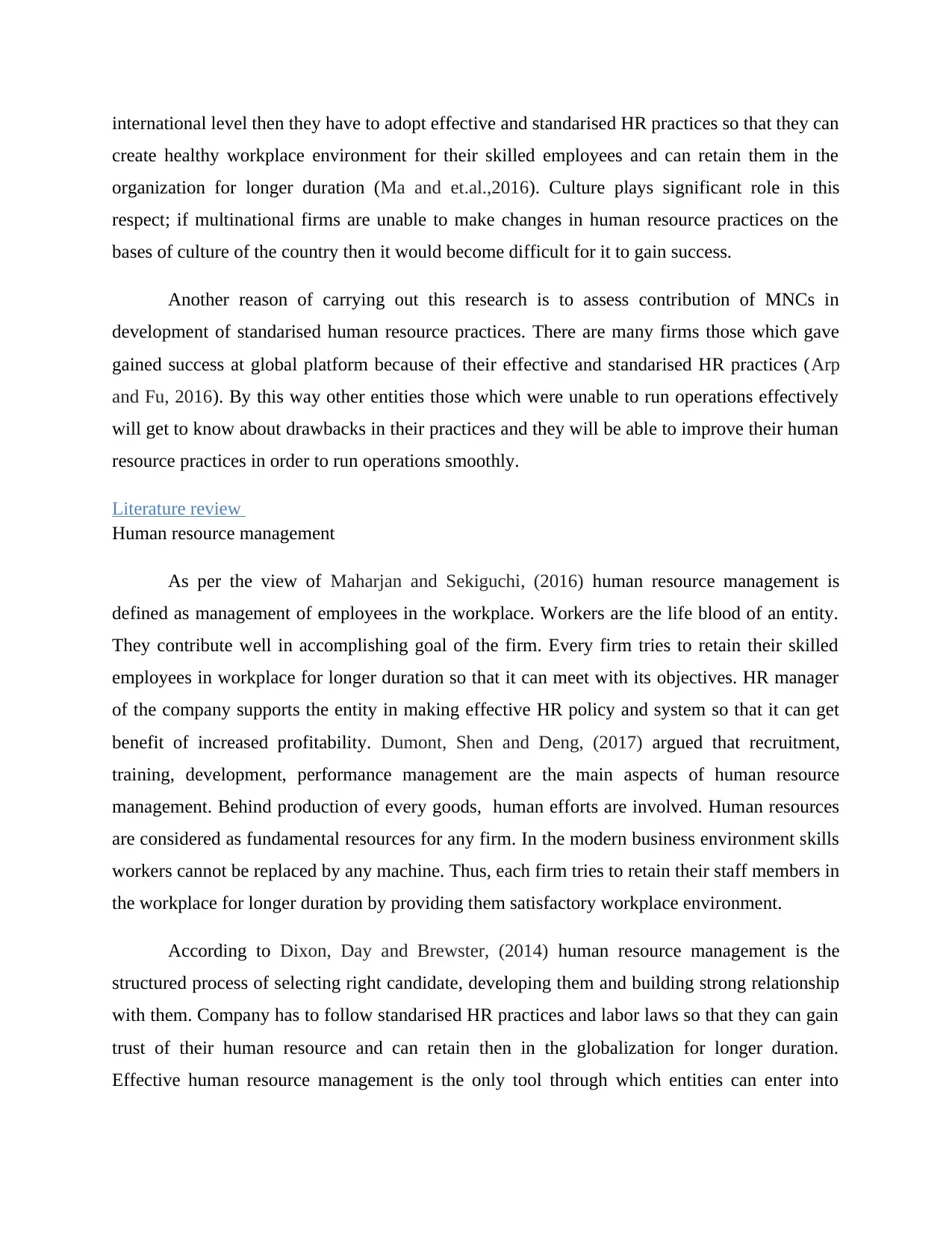
international level then they have to adopt effective and standarised HR practices so that they can
create healthy workplace environment for their skilled employees and can retain them in the
organization for longer duration (Ma and et.al.,2016). Culture plays significant role in this
respect; if multinational firms are unable to make changes in human resource practices on the
bases of culture of the country then it would become difficult for it to gain success.
Another reason of carrying out this research is to assess contribution of MNCs in
development of standarised human resource practices. There are many firms those which gave
gained success at global platform because of their effective and standarised HR practices (Arp
and Fu, 2016). By this way other entities those which were unable to run operations effectively
will get to know about drawbacks in their practices and they will be able to improve their human
resource practices in order to run operations smoothly.
Literature review
Human resource management
As per the view of Maharjan and Sekiguchi, (2016) human resource management is
defined as management of employees in the workplace. Workers are the life blood of an entity.
They contribute well in accomplishing goal of the firm. Every firm tries to retain their skilled
employees in workplace for longer duration so that it can meet with its objectives. HR manager
of the company supports the entity in making effective HR policy and system so that it can get
benefit of increased profitability. Dumont, Shen and Deng, (2017) argued that recruitment,
training, development, performance management are the main aspects of human resource
management. Behind production of every goods, human efforts are involved. Human resources
are considered as fundamental resources for any firm. In the modern business environment skills
workers cannot be replaced by any machine. Thus, each firm tries to retain their staff members in
the workplace for longer duration by providing them satisfactory workplace environment.
According to Dixon, Day and Brewster, (2014) human resource management is the
structured process of selecting right candidate, developing them and building strong relationship
with them. Company has to follow standarised HR practices and labor laws so that they can gain
trust of their human resource and can retain then in the globalization for longer duration.
Effective human resource management is the only tool through which entities can enter into
create healthy workplace environment for their skilled employees and can retain them in the
organization for longer duration (Ma and et.al.,2016). Culture plays significant role in this
respect; if multinational firms are unable to make changes in human resource practices on the
bases of culture of the country then it would become difficult for it to gain success.
Another reason of carrying out this research is to assess contribution of MNCs in
development of standarised human resource practices. There are many firms those which gave
gained success at global platform because of their effective and standarised HR practices (Arp
and Fu, 2016). By this way other entities those which were unable to run operations effectively
will get to know about drawbacks in their practices and they will be able to improve their human
resource practices in order to run operations smoothly.
Literature review
Human resource management
As per the view of Maharjan and Sekiguchi, (2016) human resource management is
defined as management of employees in the workplace. Workers are the life blood of an entity.
They contribute well in accomplishing goal of the firm. Every firm tries to retain their skilled
employees in workplace for longer duration so that it can meet with its objectives. HR manager
of the company supports the entity in making effective HR policy and system so that it can get
benefit of increased profitability. Dumont, Shen and Deng, (2017) argued that recruitment,
training, development, performance management are the main aspects of human resource
management. Behind production of every goods, human efforts are involved. Human resources
are considered as fundamental resources for any firm. In the modern business environment skills
workers cannot be replaced by any machine. Thus, each firm tries to retain their staff members in
the workplace for longer duration by providing them satisfactory workplace environment.
According to Dixon, Day and Brewster, (2014) human resource management is the
structured process of selecting right candidate, developing them and building strong relationship
with them. Company has to follow standarised HR practices and labor laws so that they can gain
trust of their human resource and can retain then in the globalization for longer duration.
Effective human resource management is the only tool through which entities can enter into
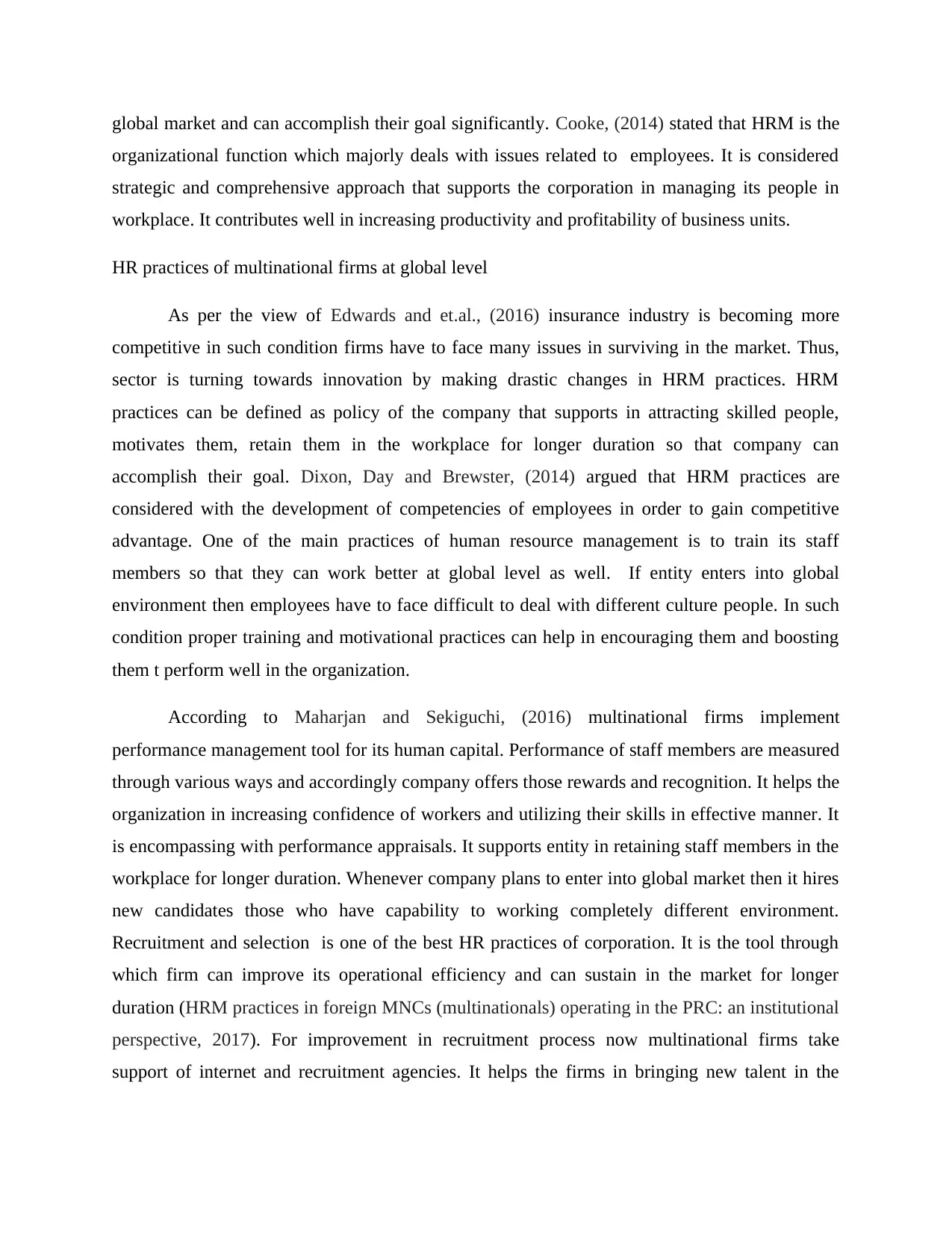
global market and can accomplish their goal significantly. Cooke, (2014) stated that HRM is the
organizational function which majorly deals with issues related to employees. It is considered
strategic and comprehensive approach that supports the corporation in managing its people in
workplace. It contributes well in increasing productivity and profitability of business units.
HR practices of multinational firms at global level
As per the view of Edwards and et.al., (2016) insurance industry is becoming more
competitive in such condition firms have to face many issues in surviving in the market. Thus,
sector is turning towards innovation by making drastic changes in HRM practices. HRM
practices can be defined as policy of the company that supports in attracting skilled people,
motivates them, retain them in the workplace for longer duration so that company can
accomplish their goal. Dixon, Day and Brewster, (2014) argued that HRM practices are
considered with the development of competencies of employees in order to gain competitive
advantage. One of the main practices of human resource management is to train its staff
members so that they can work better at global level as well. If entity enters into global
environment then employees have to face difficult to deal with different culture people. In such
condition proper training and motivational practices can help in encouraging them and boosting
them t perform well in the organization.
According to Maharjan and Sekiguchi, (2016) multinational firms implement
performance management tool for its human capital. Performance of staff members are measured
through various ways and accordingly company offers those rewards and recognition. It helps the
organization in increasing confidence of workers and utilizing their skills in effective manner. It
is encompassing with performance appraisals. It supports entity in retaining staff members in the
workplace for longer duration. Whenever company plans to enter into global market then it hires
new candidates those who have capability to working completely different environment.
Recruitment and selection is one of the best HR practices of corporation. It is the tool through
which firm can improve its operational efficiency and can sustain in the market for longer
duration (HRM practices in foreign MNCs (multinationals) operating in the PRC: an institutional
perspective, 2017). For improvement in recruitment process now multinational firms take
support of internet and recruitment agencies. It helps the firms in bringing new talent in the
organizational function which majorly deals with issues related to employees. It is considered
strategic and comprehensive approach that supports the corporation in managing its people in
workplace. It contributes well in increasing productivity and profitability of business units.
HR practices of multinational firms at global level
As per the view of Edwards and et.al., (2016) insurance industry is becoming more
competitive in such condition firms have to face many issues in surviving in the market. Thus,
sector is turning towards innovation by making drastic changes in HRM practices. HRM
practices can be defined as policy of the company that supports in attracting skilled people,
motivates them, retain them in the workplace for longer duration so that company can
accomplish their goal. Dixon, Day and Brewster, (2014) argued that HRM practices are
considered with the development of competencies of employees in order to gain competitive
advantage. One of the main practices of human resource management is to train its staff
members so that they can work better at global level as well. If entity enters into global
environment then employees have to face difficult to deal with different culture people. In such
condition proper training and motivational practices can help in encouraging them and boosting
them t perform well in the organization.
According to Maharjan and Sekiguchi, (2016) multinational firms implement
performance management tool for its human capital. Performance of staff members are measured
through various ways and accordingly company offers those rewards and recognition. It helps the
organization in increasing confidence of workers and utilizing their skills in effective manner. It
is encompassing with performance appraisals. It supports entity in retaining staff members in the
workplace for longer duration. Whenever company plans to enter into global market then it hires
new candidates those who have capability to working completely different environment.
Recruitment and selection is one of the best HR practices of corporation. It is the tool through
which firm can improve its operational efficiency and can sustain in the market for longer
duration (HRM practices in foreign MNCs (multinationals) operating in the PRC: an institutional
perspective, 2017). For improvement in recruitment process now multinational firms take
support of internet and recruitment agencies. It helps the firms in bringing new talent in the
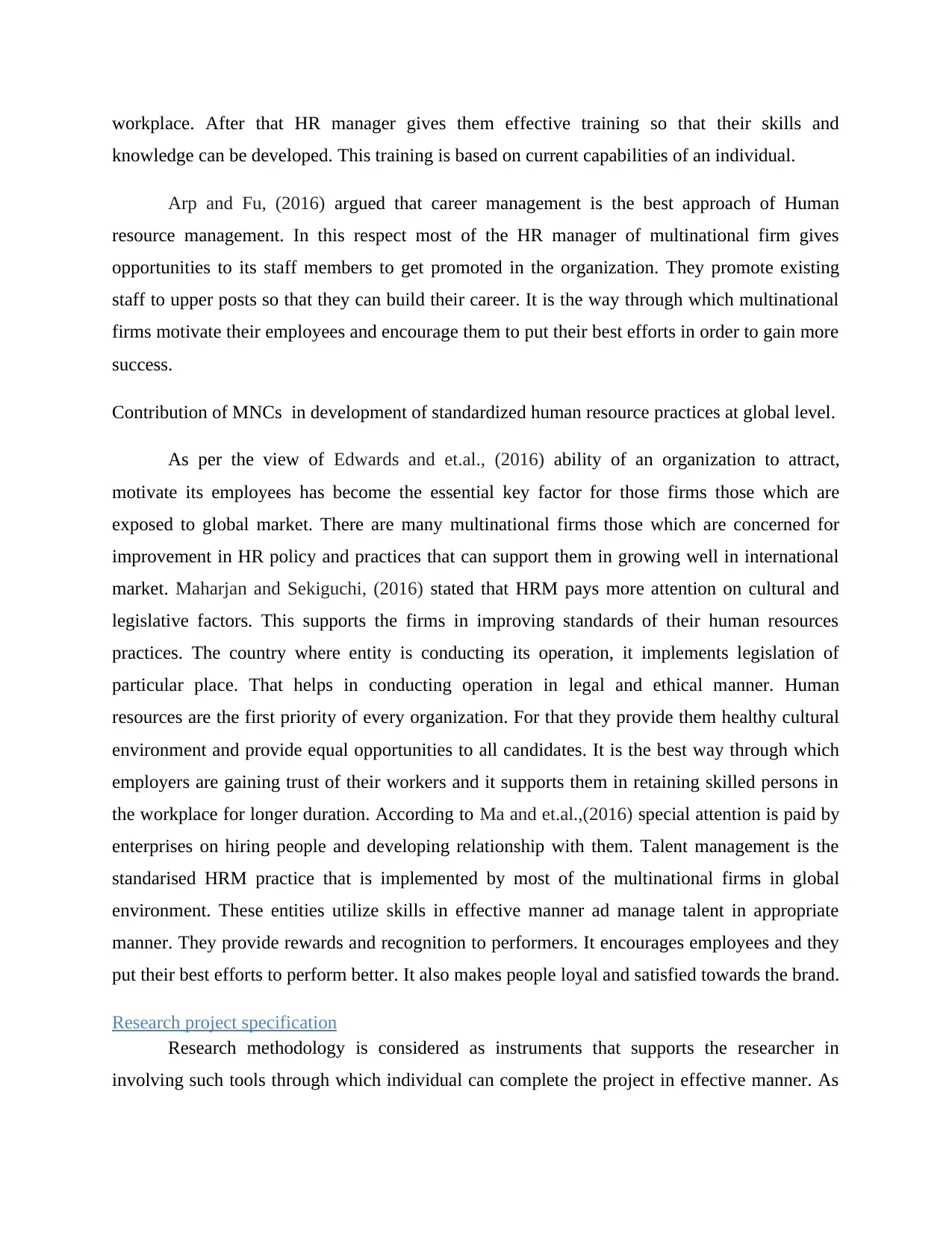
workplace. After that HR manager gives them effective training so that their skills and
knowledge can be developed. This training is based on current capabilities of an individual.
Arp and Fu, (2016) argued that career management is the best approach of Human
resource management. In this respect most of the HR manager of multinational firm gives
opportunities to its staff members to get promoted in the organization. They promote existing
staff to upper posts so that they can build their career. It is the way through which multinational
firms motivate their employees and encourage them to put their best efforts in order to gain more
success.
Contribution of MNCs in development of standardized human resource practices at global level.
As per the view of Edwards and et.al., (2016) ability of an organization to attract,
motivate its employees has become the essential key factor for those firms those which are
exposed to global market. There are many multinational firms those which are concerned for
improvement in HR policy and practices that can support them in growing well in international
market. Maharjan and Sekiguchi, (2016) stated that HRM pays more attention on cultural and
legislative factors. This supports the firms in improving standards of their human resources
practices. The country where entity is conducting its operation, it implements legislation of
particular place. That helps in conducting operation in legal and ethical manner. Human
resources are the first priority of every organization. For that they provide them healthy cultural
environment and provide equal opportunities to all candidates. It is the best way through which
employers are gaining trust of their workers and it supports them in retaining skilled persons in
the workplace for longer duration. According to Ma and et.al.,(2016) special attention is paid by
enterprises on hiring people and developing relationship with them. Talent management is the
standarised HRM practice that is implemented by most of the multinational firms in global
environment. These entities utilize skills in effective manner ad manage talent in appropriate
manner. They provide rewards and recognition to performers. It encourages employees and they
put their best efforts to perform better. It also makes people loyal and satisfied towards the brand.
Research project specification
Research methodology is considered as instruments that supports the researcher in
involving such tools through which individual can complete the project in effective manner. As
knowledge can be developed. This training is based on current capabilities of an individual.
Arp and Fu, (2016) argued that career management is the best approach of Human
resource management. In this respect most of the HR manager of multinational firm gives
opportunities to its staff members to get promoted in the organization. They promote existing
staff to upper posts so that they can build their career. It is the way through which multinational
firms motivate their employees and encourage them to put their best efforts in order to gain more
success.
Contribution of MNCs in development of standardized human resource practices at global level.
As per the view of Edwards and et.al., (2016) ability of an organization to attract,
motivate its employees has become the essential key factor for those firms those which are
exposed to global market. There are many multinational firms those which are concerned for
improvement in HR policy and practices that can support them in growing well in international
market. Maharjan and Sekiguchi, (2016) stated that HRM pays more attention on cultural and
legislative factors. This supports the firms in improving standards of their human resources
practices. The country where entity is conducting its operation, it implements legislation of
particular place. That helps in conducting operation in legal and ethical manner. Human
resources are the first priority of every organization. For that they provide them healthy cultural
environment and provide equal opportunities to all candidates. It is the best way through which
employers are gaining trust of their workers and it supports them in retaining skilled persons in
the workplace for longer duration. According to Ma and et.al.,(2016) special attention is paid by
enterprises on hiring people and developing relationship with them. Talent management is the
standarised HRM practice that is implemented by most of the multinational firms in global
environment. These entities utilize skills in effective manner ad manage talent in appropriate
manner. They provide rewards and recognition to performers. It encourages employees and they
put their best efforts to perform better. It also makes people loyal and satisfied towards the brand.
Research project specification
Research methodology is considered as instruments that supports the researcher in
involving such tools through which individual can complete the project in effective manner. As
Paraphrase This Document
Need a fresh take? Get an instant paraphrase of this document with our AI Paraphraser
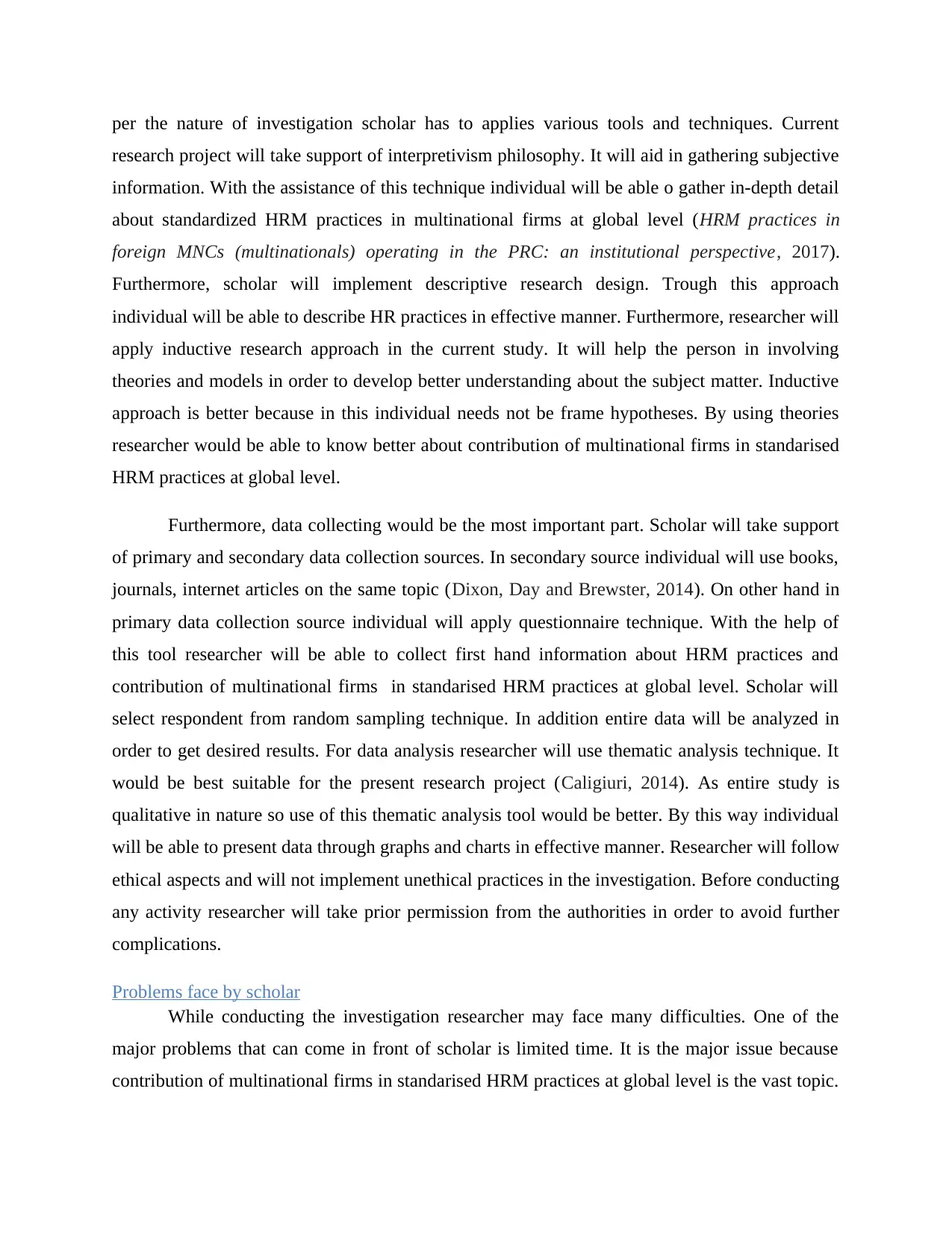
per the nature of investigation scholar has to applies various tools and techniques. Current
research project will take support of interpretivism philosophy. It will aid in gathering subjective
information. With the assistance of this technique individual will be able o gather in-depth detail
about standardized HRM practices in multinational firms at global level (HRM practices in
foreign MNCs (multinationals) operating in the PRC: an institutional perspective, 2017).
Furthermore, scholar will implement descriptive research design. Trough this approach
individual will be able to describe HR practices in effective manner. Furthermore, researcher will
apply inductive research approach in the current study. It will help the person in involving
theories and models in order to develop better understanding about the subject matter. Inductive
approach is better because in this individual needs not be frame hypotheses. By using theories
researcher would be able to know better about contribution of multinational firms in standarised
HRM practices at global level.
Furthermore, data collecting would be the most important part. Scholar will take support
of primary and secondary data collection sources. In secondary source individual will use books,
journals, internet articles on the same topic (Dixon, Day and Brewster, 2014). On other hand in
primary data collection source individual will apply questionnaire technique. With the help of
this tool researcher will be able to collect first hand information about HRM practices and
contribution of multinational firms in standarised HRM practices at global level. Scholar will
select respondent from random sampling technique. In addition entire data will be analyzed in
order to get desired results. For data analysis researcher will use thematic analysis technique. It
would be best suitable for the present research project (Caligiuri, 2014). As entire study is
qualitative in nature so use of this thematic analysis tool would be better. By this way individual
will be able to present data through graphs and charts in effective manner. Researcher will follow
ethical aspects and will not implement unethical practices in the investigation. Before conducting
any activity researcher will take prior permission from the authorities in order to avoid further
complications.
Problems face by scholar
While conducting the investigation researcher may face many difficulties. One of the
major problems that can come in front of scholar is limited time. It is the major issue because
contribution of multinational firms in standarised HRM practices at global level is the vast topic.
research project will take support of interpretivism philosophy. It will aid in gathering subjective
information. With the assistance of this technique individual will be able o gather in-depth detail
about standardized HRM practices in multinational firms at global level (HRM practices in
foreign MNCs (multinationals) operating in the PRC: an institutional perspective, 2017).
Furthermore, scholar will implement descriptive research design. Trough this approach
individual will be able to describe HR practices in effective manner. Furthermore, researcher will
apply inductive research approach in the current study. It will help the person in involving
theories and models in order to develop better understanding about the subject matter. Inductive
approach is better because in this individual needs not be frame hypotheses. By using theories
researcher would be able to know better about contribution of multinational firms in standarised
HRM practices at global level.
Furthermore, data collecting would be the most important part. Scholar will take support
of primary and secondary data collection sources. In secondary source individual will use books,
journals, internet articles on the same topic (Dixon, Day and Brewster, 2014). On other hand in
primary data collection source individual will apply questionnaire technique. With the help of
this tool researcher will be able to collect first hand information about HRM practices and
contribution of multinational firms in standarised HRM practices at global level. Scholar will
select respondent from random sampling technique. In addition entire data will be analyzed in
order to get desired results. For data analysis researcher will use thematic analysis technique. It
would be best suitable for the present research project (Caligiuri, 2014). As entire study is
qualitative in nature so use of this thematic analysis tool would be better. By this way individual
will be able to present data through graphs and charts in effective manner. Researcher will follow
ethical aspects and will not implement unethical practices in the investigation. Before conducting
any activity researcher will take prior permission from the authorities in order to avoid further
complications.
Problems face by scholar
While conducting the investigation researcher may face many difficulties. One of the
major problems that can come in front of scholar is limited time. It is the major issue because
contribution of multinational firms in standarised HRM practices at global level is the vast topic.
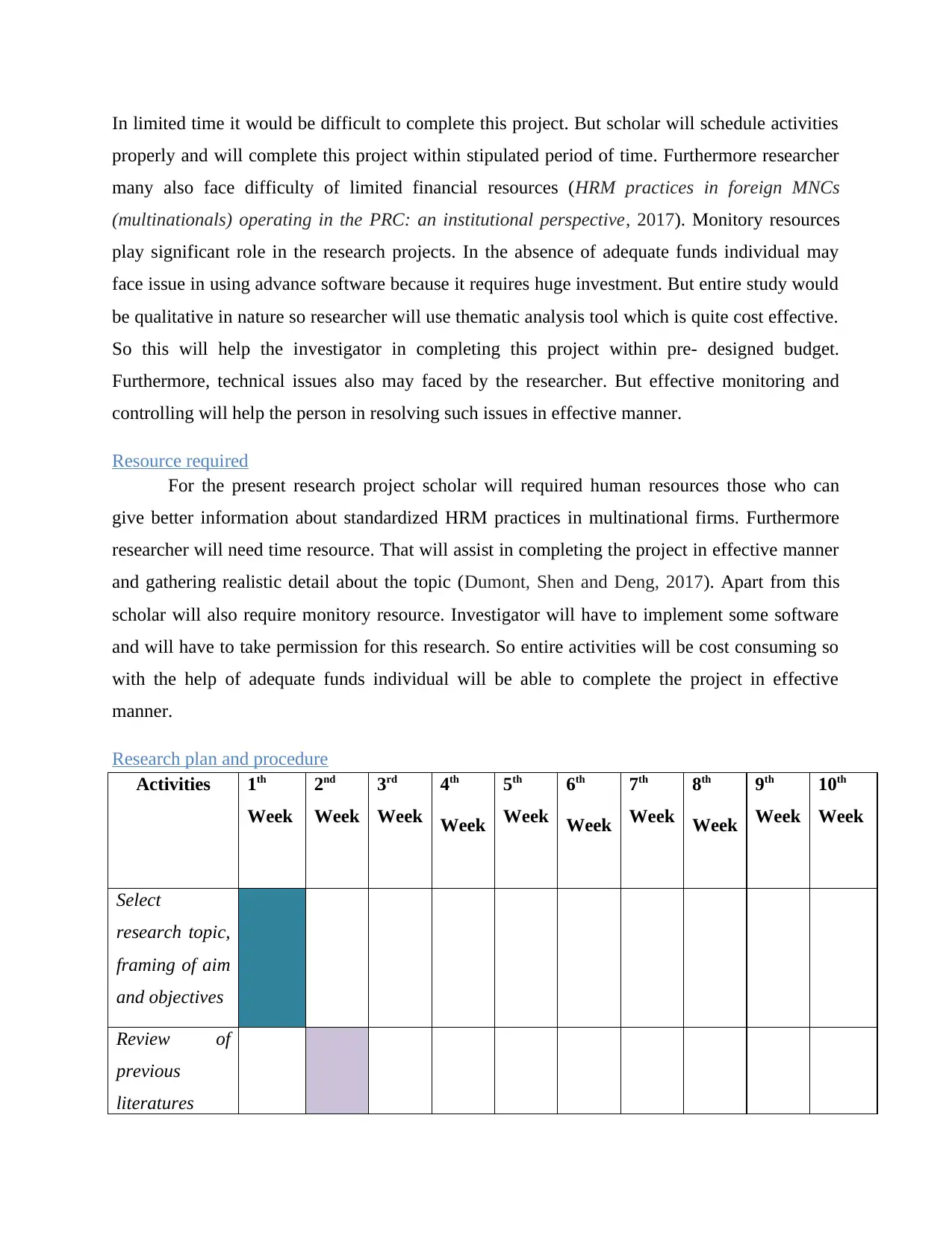
In limited time it would be difficult to complete this project. But scholar will schedule activities
properly and will complete this project within stipulated period of time. Furthermore researcher
many also face difficulty of limited financial resources (HRM practices in foreign MNCs
(multinationals) operating in the PRC: an institutional perspective, 2017). Monitory resources
play significant role in the research projects. In the absence of adequate funds individual may
face issue in using advance software because it requires huge investment. But entire study would
be qualitative in nature so researcher will use thematic analysis tool which is quite cost effective.
So this will help the investigator in completing this project within pre- designed budget.
Furthermore, technical issues also may faced by the researcher. But effective monitoring and
controlling will help the person in resolving such issues in effective manner.
Resource required
For the present research project scholar will required human resources those who can
give better information about standardized HRM practices in multinational firms. Furthermore
researcher will need time resource. That will assist in completing the project in effective manner
and gathering realistic detail about the topic (Dumont, Shen and Deng, 2017). Apart from this
scholar will also require monitory resource. Investigator will have to implement some software
and will have to take permission for this research. So entire activities will be cost consuming so
with the help of adequate funds individual will be able to complete the project in effective
manner.
Research plan and procedure
Activities 1th
Week
2nd
Week
3rd
Week
4th
Week
5th
Week
6th
Week
7th
Week
8th
Week
9th
Week
10th
Week
Select
research topic,
framing of aim
and objectives
Review of
previous
literatures
properly and will complete this project within stipulated period of time. Furthermore researcher
many also face difficulty of limited financial resources (HRM practices in foreign MNCs
(multinationals) operating in the PRC: an institutional perspective, 2017). Monitory resources
play significant role in the research projects. In the absence of adequate funds individual may
face issue in using advance software because it requires huge investment. But entire study would
be qualitative in nature so researcher will use thematic analysis tool which is quite cost effective.
So this will help the investigator in completing this project within pre- designed budget.
Furthermore, technical issues also may faced by the researcher. But effective monitoring and
controlling will help the person in resolving such issues in effective manner.
Resource required
For the present research project scholar will required human resources those who can
give better information about standardized HRM practices in multinational firms. Furthermore
researcher will need time resource. That will assist in completing the project in effective manner
and gathering realistic detail about the topic (Dumont, Shen and Deng, 2017). Apart from this
scholar will also require monitory resource. Investigator will have to implement some software
and will have to take permission for this research. So entire activities will be cost consuming so
with the help of adequate funds individual will be able to complete the project in effective
manner.
Research plan and procedure
Activities 1th
Week
2nd
Week
3rd
Week
4th
Week
5th
Week
6th
Week
7th
Week
8th
Week
9th
Week
10th
Week
Select
research topic,
framing of aim
and objectives
Review of
previous
literatures
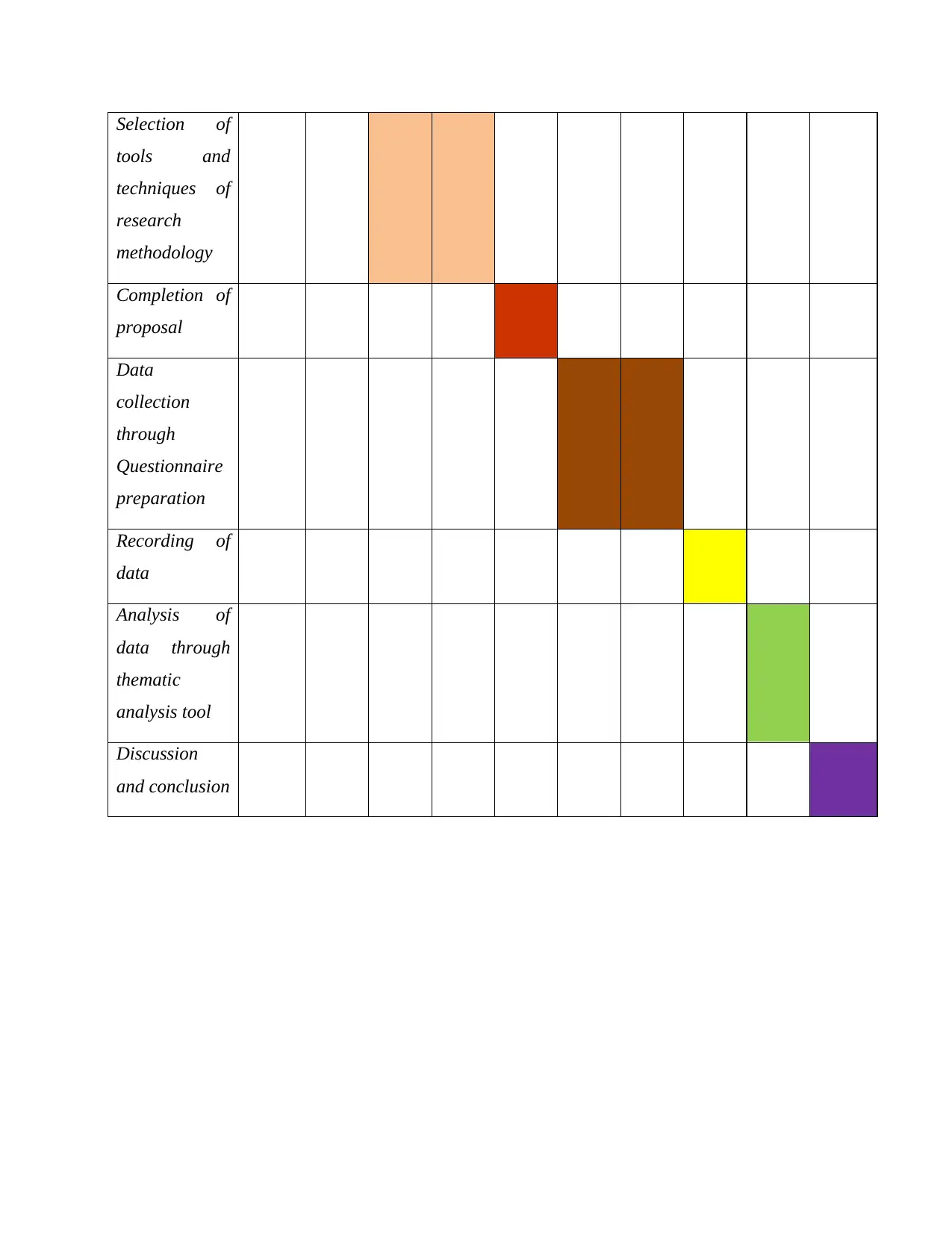
Selection of
tools and
techniques of
research
methodology
Completion of
proposal
Data
collection
through
Questionnaire
preparation
Recording of
data
Analysis of
data through
thematic
analysis tool
Discussion
and conclusion
tools and
techniques of
research
methodology
Completion of
proposal
Data
collection
through
Questionnaire
preparation
Recording of
data
Analysis of
data through
thematic
analysis tool
Discussion
and conclusion
Secure Best Marks with AI Grader
Need help grading? Try our AI Grader for instant feedback on your assignments.
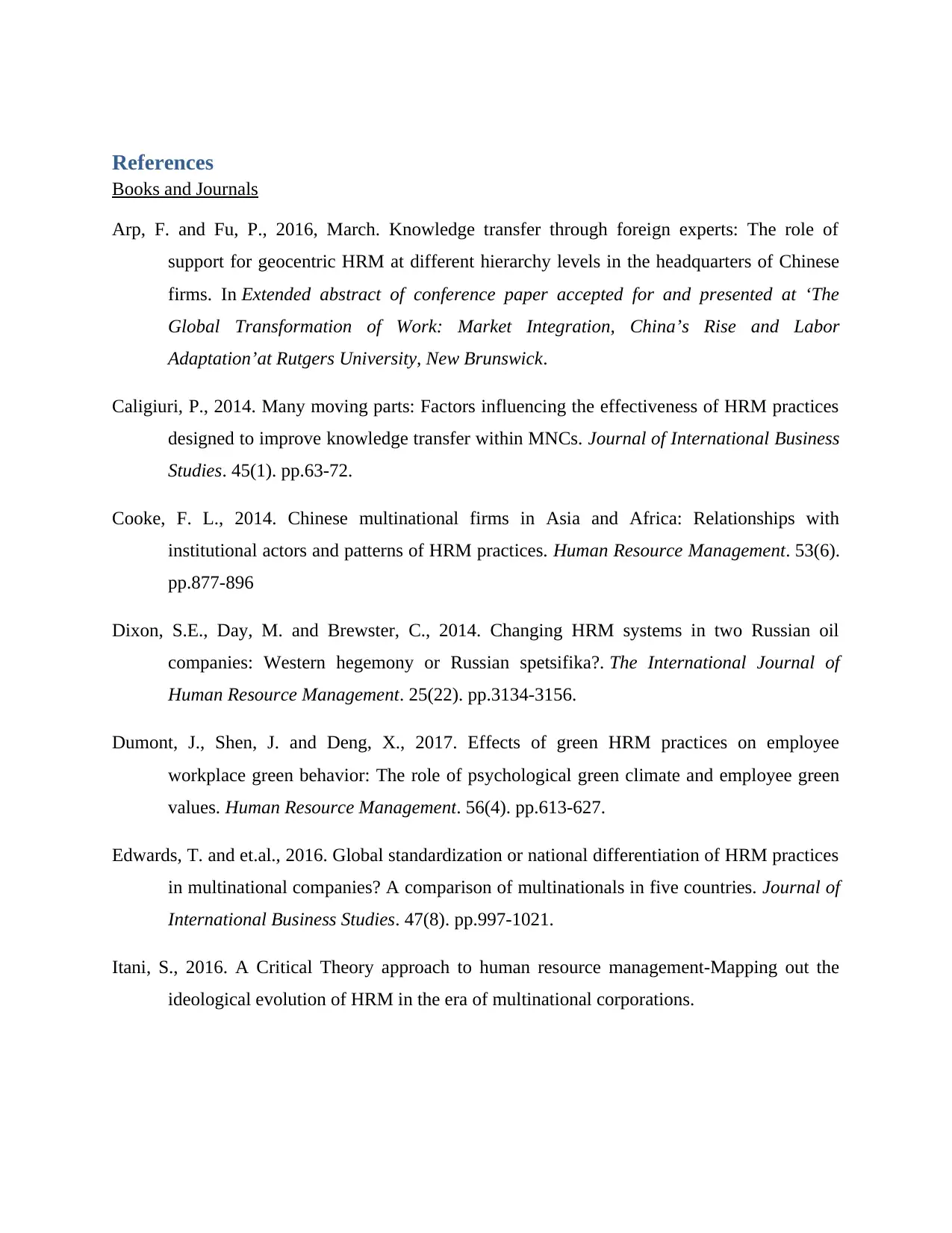
References
Books and Journals
Arp, F. and Fu, P., 2016, March. Knowledge transfer through foreign experts: The role of
support for geocentric HRM at different hierarchy levels in the headquarters of Chinese
firms. In Extended abstract of conference paper accepted for and presented at ‘The
Global Transformation of Work: Market Integration, China’s Rise and Labor
Adaptation’at Rutgers University, New Brunswick.
Caligiuri, P., 2014. Many moving parts: Factors influencing the effectiveness of HRM practices
designed to improve knowledge transfer within MNCs. Journal of International Business
Studies. 45(1). pp.63-72.
Cooke, F. L., 2014. Chinese multinational firms in Asia and Africa: Relationships with
institutional actors and patterns of HRM practices. Human Resource Management. 53(6).
pp.877-896
Dixon, S.E., Day, M. and Brewster, C., 2014. Changing HRM systems in two Russian oil
companies: Western hegemony or Russian spetsifika?. The International Journal of
Human Resource Management. 25(22). pp.3134-3156.
Dumont, J., Shen, J. and Deng, X., 2017. Effects of green HRM practices on employee
workplace green behavior: The role of psychological green climate and employee green
values. Human Resource Management. 56(4). pp.613-627.
Edwards, T. and et.al., 2016. Global standardization or national differentiation of HRM practices
in multinational companies? A comparison of multinationals in five countries. Journal of
International Business Studies. 47(8). pp.997-1021.
Itani, S., 2016. A Critical Theory approach to human resource management-Mapping out the
ideological evolution of HRM in the era of multinational corporations.
Books and Journals
Arp, F. and Fu, P., 2016, March. Knowledge transfer through foreign experts: The role of
support for geocentric HRM at different hierarchy levels in the headquarters of Chinese
firms. In Extended abstract of conference paper accepted for and presented at ‘The
Global Transformation of Work: Market Integration, China’s Rise and Labor
Adaptation’at Rutgers University, New Brunswick.
Caligiuri, P., 2014. Many moving parts: Factors influencing the effectiveness of HRM practices
designed to improve knowledge transfer within MNCs. Journal of International Business
Studies. 45(1). pp.63-72.
Cooke, F. L., 2014. Chinese multinational firms in Asia and Africa: Relationships with
institutional actors and patterns of HRM practices. Human Resource Management. 53(6).
pp.877-896
Dixon, S.E., Day, M. and Brewster, C., 2014. Changing HRM systems in two Russian oil
companies: Western hegemony or Russian spetsifika?. The International Journal of
Human Resource Management. 25(22). pp.3134-3156.
Dumont, J., Shen, J. and Deng, X., 2017. Effects of green HRM practices on employee
workplace green behavior: The role of psychological green climate and employee green
values. Human Resource Management. 56(4). pp.613-627.
Edwards, T. and et.al., 2016. Global standardization or national differentiation of HRM practices
in multinational companies? A comparison of multinationals in five countries. Journal of
International Business Studies. 47(8). pp.997-1021.
Itani, S., 2016. A Critical Theory approach to human resource management-Mapping out the
ideological evolution of HRM in the era of multinational corporations.
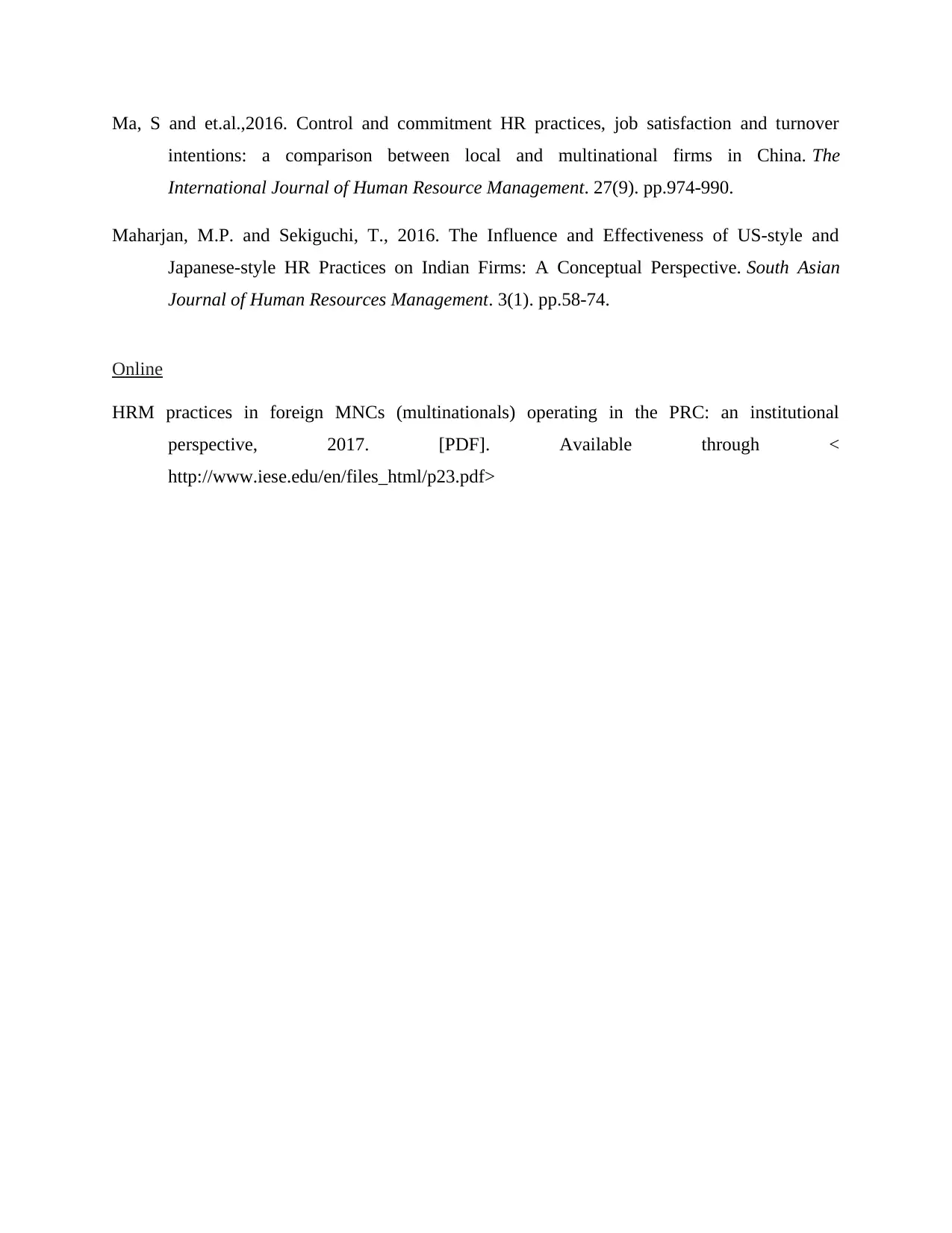
Ma, S and et.al.,2016. Control and commitment HR practices, job satisfaction and turnover
intentions: a comparison between local and multinational firms in China. The
International Journal of Human Resource Management. 27(9). pp.974-990.
Maharjan, M.P. and Sekiguchi, T., 2016. The Influence and Effectiveness of US-style and
Japanese-style HR Practices on Indian Firms: A Conceptual Perspective. South Asian
Journal of Human Resources Management. 3(1). pp.58-74.
Online
HRM practices in foreign MNCs (multinationals) operating in the PRC: an institutional
perspective, 2017. [PDF]. Available through <
http://www.iese.edu/en/files_html/p23.pdf>
intentions: a comparison between local and multinational firms in China. The
International Journal of Human Resource Management. 27(9). pp.974-990.
Maharjan, M.P. and Sekiguchi, T., 2016. The Influence and Effectiveness of US-style and
Japanese-style HR Practices on Indian Firms: A Conceptual Perspective. South Asian
Journal of Human Resources Management. 3(1). pp.58-74.
Online
HRM practices in foreign MNCs (multinationals) operating in the PRC: an institutional
perspective, 2017. [PDF]. Available through <
http://www.iese.edu/en/files_html/p23.pdf>
1 out of 12
Related Documents
Your All-in-One AI-Powered Toolkit for Academic Success.
+13062052269
info@desklib.com
Available 24*7 on WhatsApp / Email
![[object Object]](/_next/static/media/star-bottom.7253800d.svg)
Unlock your academic potential
© 2024 | Zucol Services PVT LTD | All rights reserved.





